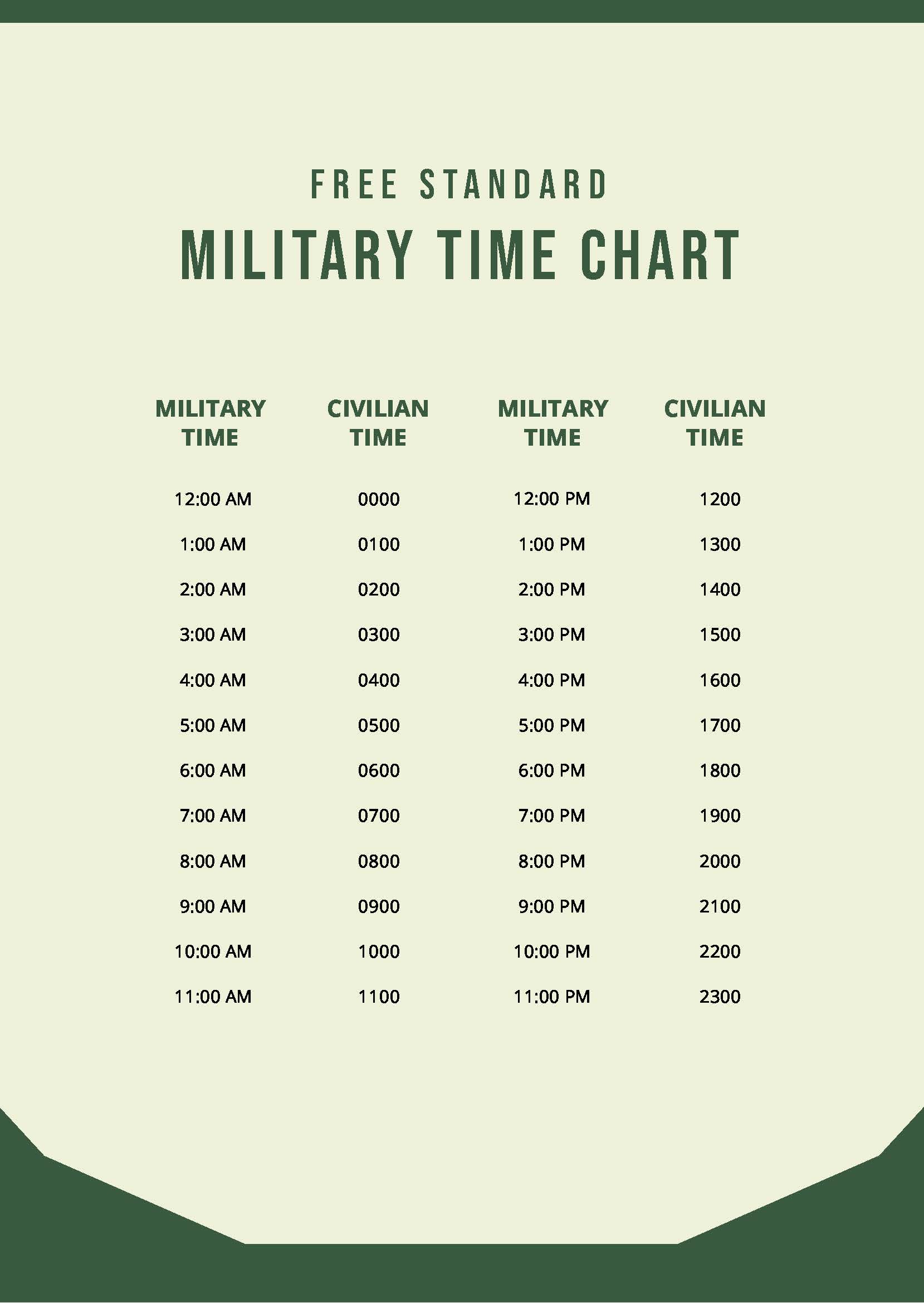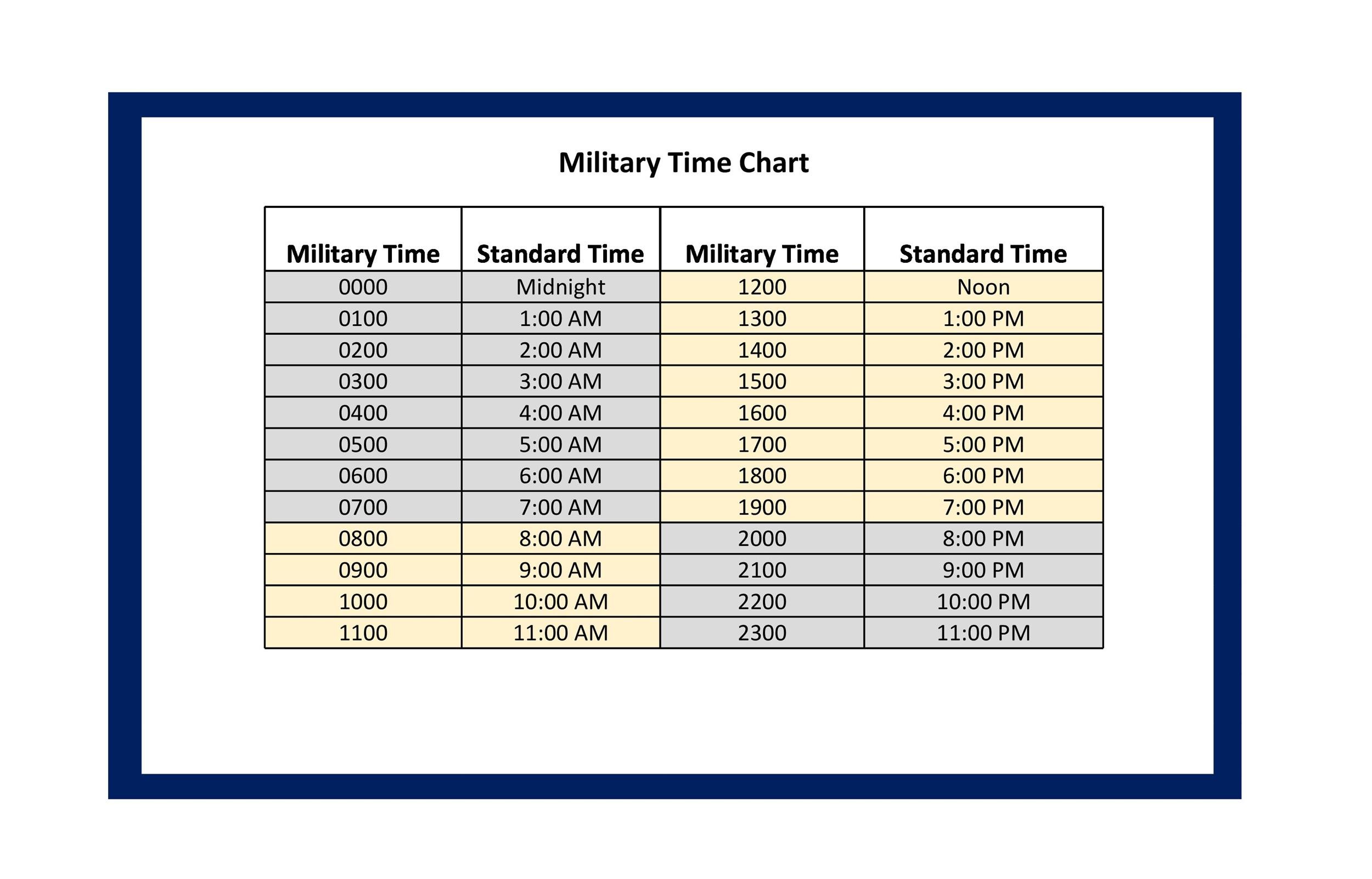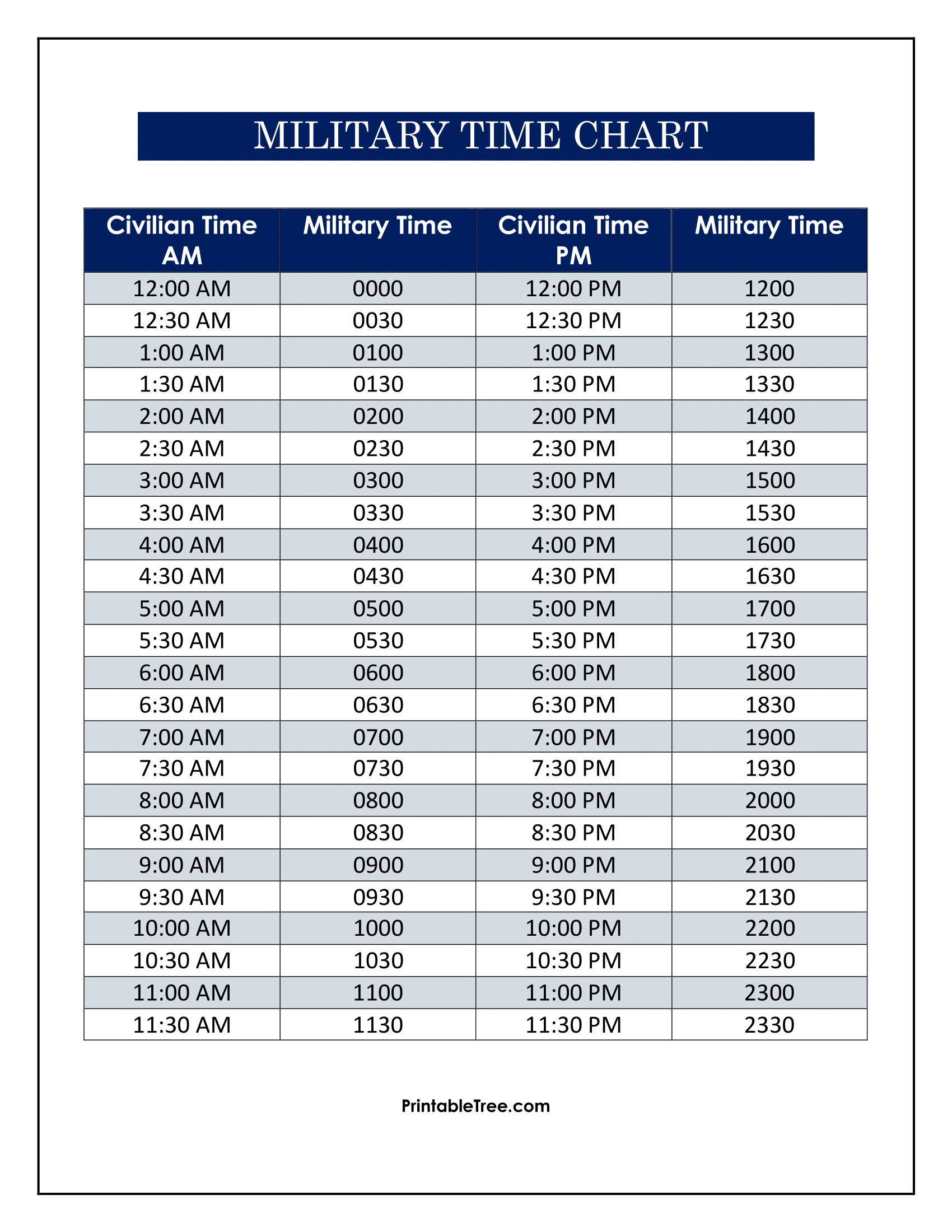Mastering Military Time: Your Essential 24-Hour Chart Guide
In a world that increasingly values precision and clarity, understanding how time is communicated is more critical than ever. While most of us are accustomed to the familiar 12-hour AM/PM system, there's another format that reigns supreme in professional, scientific, and military contexts: military time. This 24-hour clock system eliminates ambiguity, ensuring that whether it's 8 AM or 8 PM, there's absolutely no room for confusion. Navigating this system, especially for beginners, can seem daunting, but with the right tools, it becomes second nature. That's where an army time chart becomes your invaluable companion.
This comprehensive guide will demystify military time, explaining its core principles, demonstrating why it's the international standard for clarity, and most importantly, showing you how to effectively use an army time chart to convert, understand, and even pronounce these unique time designations. Whether you're planning schedules, logging critical hours, or simply seeking to enhance your general knowledge, mastering military time and leveraging an easy-to-read military time chart will simplify your life and help you avoid common time-related errors.
Table of Contents
- What Exactly is Military Time?
- The Indispensable Army Time Chart: Your Conversion Companion
- Standard to Military Time Conversion: The Core Principles
- Beyond the Basics: Pronunciation and Professionalism
- Why Military Time Matters: Precision in Critical Fields
- Accessing Your Army Time Chart: Tools and Resources
- Common Misconceptions and Tips for Mastery
What Exactly is Military Time?
At its heart, military time is a method of keeping hours in which the day runs from midnight to midnight and is divided into 24-hour increments. Unlike the standard 12-hour clock, which cycles through AM and PM, military time operates on a continuous 24-hour cycle. This means that after 12:00 PM (noon), the hours continue to count up: 1:00 PM becomes 1300, 2:00 PM becomes 1400, and so on, all the way up to 2359 (11:59 PM). Midnight is typically represented as 0000, though 2400 can also be used to denote the end of a day.
The primary advantage of this 24-hour format is its unparalleled clarity. There's no need for AM or PM designators, eliminating any potential for misinterpretation, especially in situations where a simple mistake could have severe consequences. This clock format has become the international time standard precisely because it is clear, concise, and unambiguous. It's the language of time for professionals who cannot afford errors, from pilots and air traffic controllers to medical personnel and emergency responders. Learning the basics of military time is the first step towards adopting this globally recognized standard.
The Indispensable Army Time Chart: Your Conversion Companion
While the concept of military time is straightforward, the mental arithmetic of converting between standard and 24-hour formats, especially for times past noon, can be a hurdle for many. This is where an army time chart truly shines. It serves as a comprehensive reference, displaying all 24 hours of military time, their equivalent standard time, and often, the correct military time pronunciations. Whether you’re learning military time from scratch or simply need a quick reference, this table simplifies the conversion process.
An easy-to-read military time chart is designed to help you read and understand it effortlessly. The chart is neatly divided, typically into two columns: one lists the hours of a standard day (e.g., 1:00 AM, 2:00 PM), while the other aligns these times with their military format (e.g., 0100, 1400). Some advanced charts also include a third column for common pronunciations, which is incredibly helpful for those who need to communicate military time verbally. Features of a good military time chart include:
- Clarity: Designed in a way to help you read and understand it effortlessly.
- Comprehensiveness: Displays all 24 hours of military time and their standard equivalents.
- Accuracy: Ensures correct conversions, helping you avoid mistakes and keep things simple.
- Pronunciation Guide: Often includes a guide for correct military time pronunciations.
Using such a chart, you can quickly convert any time value to military time (army clock) format, making it an indispensable tool for anyone who regularly deals with time-sensitive information or simply wishes to be more precise in their daily scheduling.
Decoding the Chart: How to Read Your Army Time Chart
Reading a military time chart is straightforward once you understand the basics. You just need to search the regular time from the left side column of the chart and find the military timing corresponding to it. For instance, if you're looking for 3:00 PM, you would find "3:00 PM" in the standard time column and then look across to the military time column to see "1500." Conversely, if you encounter "0900" in a schedule and need to know its standard time equivalent, you'd locate "0900" in the military time column and see that it corresponds to "9:00 AM."
The chart simplifies the process of translating between standard and military time formats easily. It acts as a visual aid, reinforcing the conversion rules without requiring you to perform mental calculations every time. This visual comparison allows you to quickly grasp the relationship between the two systems, enhancing your understanding and use of military time.
Standard to Military Time Conversion: The Core Principles
While an army time chart is a fantastic reference, understanding the underlying conversion principles empowers you to perform conversions even without the chart. Military time is based on a 24-hour clock instead of using the standard 12-hour clock. The day lasts from midnight to midnight, with hours beginning at 00 and going up to 23.
- Midnight: 0000 and 2400 in military time are the same as 12:00 AM midnight. 0000 signifies the beginning of a new day, while 2400 signifies the end of the previous day. For consistency in scheduling, 0000 is generally preferred for start times.
- 12:00 AM to 12:59 AM: These hours are represented by 0000 to 0059. For example, 12:30 AM is 0030.
- 1:00 AM to 11:59 AM: These times are straightforward. Simply add a leading zero if the hour is a single digit and remove the AM. For example, 1:00 AM is 0100, and 9:45 AM is 0945.
- 12:00 PM (Noon): This remains 1200 in military time.
- 1:00 PM to 11:59 PM: This is where the main conversion rule applies. For any hour from 1:00 PM onwards, you add 12 to the standard hour. For example, 1:00 PM becomes 1300 (1 + 12), 2:00 PM becomes 1400 (2 + 12), and so on. If military time is 1300 to 2359, you can insert a colon (though not typically used in official military time) and subtract 12 hours to get the standard time, then include PM to indicate the time is after 12:00 noon. For example, 1700 is 5:00 PM (17 - 12).
This consistent, additive approach for afternoon and evening hours is what makes the 24-hour system so unambiguous. There's no possibility of confusing 0700 (7 AM) with 1900 (7 PM).
Practical Examples: Navigating Your Army Time Chart
Let's put these principles into practice, demonstrating how an army time chart simplifies these conversions:
- Standard: 6:00 AM
- Military Time: 0600
- On the chart: Find "6:00 AM" in the standard column, look across to find "0600."
- Standard: 11:30 AM
- Military Time: 1130
- On the chart: Find "11:30 AM," look across to find "1130."
- Standard: 4:15 PM
- Military Time: 1615 (4 + 12 = 16)
- On the chart: Find "4:15 PM," look across to find "1615."
- Standard: 9:00 PM
- Military Time: 2100 (9 + 12 = 21)
- On the chart: Find "9:00 PM," look across to find "2100."
- Standard: 12:00 AM (Midnight)
- Military Time: 0000 (beginning of day) or 2400 (end of day)
- On the chart: Both 12:00 AM and 24:00 will point to 0000/2400.
These examples highlight how the chart provides an immediate, visual confirmation of the conversion, making it a powerful learning and reference tool. Whether you're planning schedules, logging hours, or just need a quick reference, these charts help you avoid mistakes and keep things simple.
Beyond the Basics: Pronunciation and Professionalism
Understanding the numbers is one thing, but speaking military time correctly is another layer of proficiency. The pronunciation of military time often follows specific conventions to further enhance clarity and avoid mishearing. Generally, each digit is pronounced individually, and "hundred" is added for on-the-hour times, while "hundred" or "zero" is used for minutes. For instance:
- 0100: "Zero one hundred" or "Oh one hundred"
- 0530: "Zero five thirty" or "Oh five thirty"
- 1300: "Thirteen hundred"
- 1445: "Fourteen forty-five"
- 2000: "Twenty hundred"
- 2359: "Twenty-three fifty-nine"
Many comprehensive military time charts include a pronunciation guide, which is incredibly useful for those who need to communicate in this format verbally. Mastering both the conversion and the pronunciation reflects a high level of professionalism and attention to detail, particularly in fields where precise communication is paramount.
Why Military Time Matters: Precision in Critical Fields
The widespread adoption of military time, particularly in critical sectors, underscores its importance. Its unambiguous nature is not merely a convenience; it's a safety and efficiency imperative. Consider the following scenarios:
- Aviation: Pilots and air traffic controllers communicate using military time (often referred to as Zulu Time, which is UTC). This ensures that flight plans, take-off, and landing times are universally understood, regardless of time zones, preventing catastrophic errors.
- Healthcare: In hospitals, medication schedules, patient observations, and surgical timings are often recorded in military time. This eliminates any doubt about when a critical event occurred or is scheduled to occur, vital for patient safety.
- Emergency Services: Police, fire, and ambulance services use military time for dispatch, incident logging, and inter-agency communication. This precision is crucial when coordinating responses to emergencies.
- Logistics and Transportation: Shipping, rail, and trucking industries rely on military time for scheduling, tracking, and coordinating movements across different time zones, ensuring timely delivery and operational efficiency.
- Scientific Research: Experiments and data collection often require precise timestamps. Military time provides a consistent, global standard for recording observations.
In all these fields, the elimination of AM/PM confusion means less room for error, faster communication, and ultimately, better outcomes. This is why learning to use and understand a military time chart is not just a niche skill, but a valuable asset for anyone operating in a professional capacity where time is a critical factor.
Accessing Your Army Time Chart: Tools and Resources
In today's digital age, accessing an army time chart and related conversion tools is easier than ever. You don't need to be in the military to benefit from these resources. Many websites offer free military time converter tools, which allow you to instantly translate between standard and military time formats. These online tools often include a time chart and calculator, making quick conversions a breeze.
Furthermore, to enhance your understanding and use of military time, many military time charts are now available for download in various convenient formats. Whether you need a printable version to keep at your desk, an editable document for custom notes, or a spreadsheet for data manipulation, options are readily available. These downloadable charts provide a comprehensive reference, often displaying all 24 hours of military time, their equivalent standard time, and the correct military time pronunciations. Such resources make it incredibly simple to integrate military time into your daily routine or professional work, ensuring you always have a reliable reference at hand.
Common Misconceptions and Tips for Mastery
Despite its clarity, a few common misconceptions or sticking points can arise when dealing with military time. Addressing these can help solidify your understanding and make you truly proficient.
- 0000 vs. 2400: As mentioned, 0000 marks the beginning of a new day, while 2400 signifies the end of the previous day. While they represent the same moment in time (midnight), using 0000 for start times and 2400 for end times (e.g., "shift ends at 2400") can add precision. However, for most general purposes, 0000 is the more commonly used representation of midnight.
- The Colon: Military time is typically written without a colon (e.g., 1430, not 14:30). While some digital displays or informal uses might include a colon, the standard military format omits it.
- Mental Math for PM Times: The most frequent conversion challenge is remembering to add 12 for PM times. A simple trick is to always think of 1:00 PM as "one plus twelve hundred hours," which quickly gets you to 1300.
- Practice Makes Perfect: The best way to master military time is through consistent exposure and practice. Try converting your daily schedule, flight times, or TV show timings into military format. The more you use your army time chart, the faster you'll internalize the conversions.
By understanding these nuances and regularly consulting your military time chart, you'll quickly find that this 24-hour system becomes intuitive, enhancing your ability to communicate and manage time with unparalleled accuracy.
Conclusion
The journey to mastering military time, while initially seeming like a departure from the familiar, is a valuable endeavor that offers immense benefits in clarity and precision. From understanding its fundamental 24-hour structure to leveraging the power of a comprehensive army time chart, you now have the tools and knowledge to navigate this essential timekeeping system with confidence. The chart, with its easy-to-read format and clear conversions, serves as an indispensable guide, simplifying what might otherwise be a complex process.
Embracing military time means embracing a standard of communication that leaves no room for ambiguity, crucial in fields ranging from aviation to healthcare. We encourage you to utilize the various resources available, from printable charts to online converters, to integrate this skill into your daily life. Have you found a particular aspect of military time challenging or surprisingly easy? Share your experiences and tips in the comments below! And if this guide has been helpful, consider sharing it with others who might benefit from mastering the 24-hour clock.
- Jennalynnmeowri Leaked
- Mister Charles
- Spicy Village
- Morris Chestnut Movies And Tv Shows
- Alabama Gypsy Rose Jennings

Military Time Sheet Chart in PDF - Download | Template.net

30 Printable Military Time Charts ᐅ TemplateLab

Free Printable Military Time Chart Templates - Printable Tree